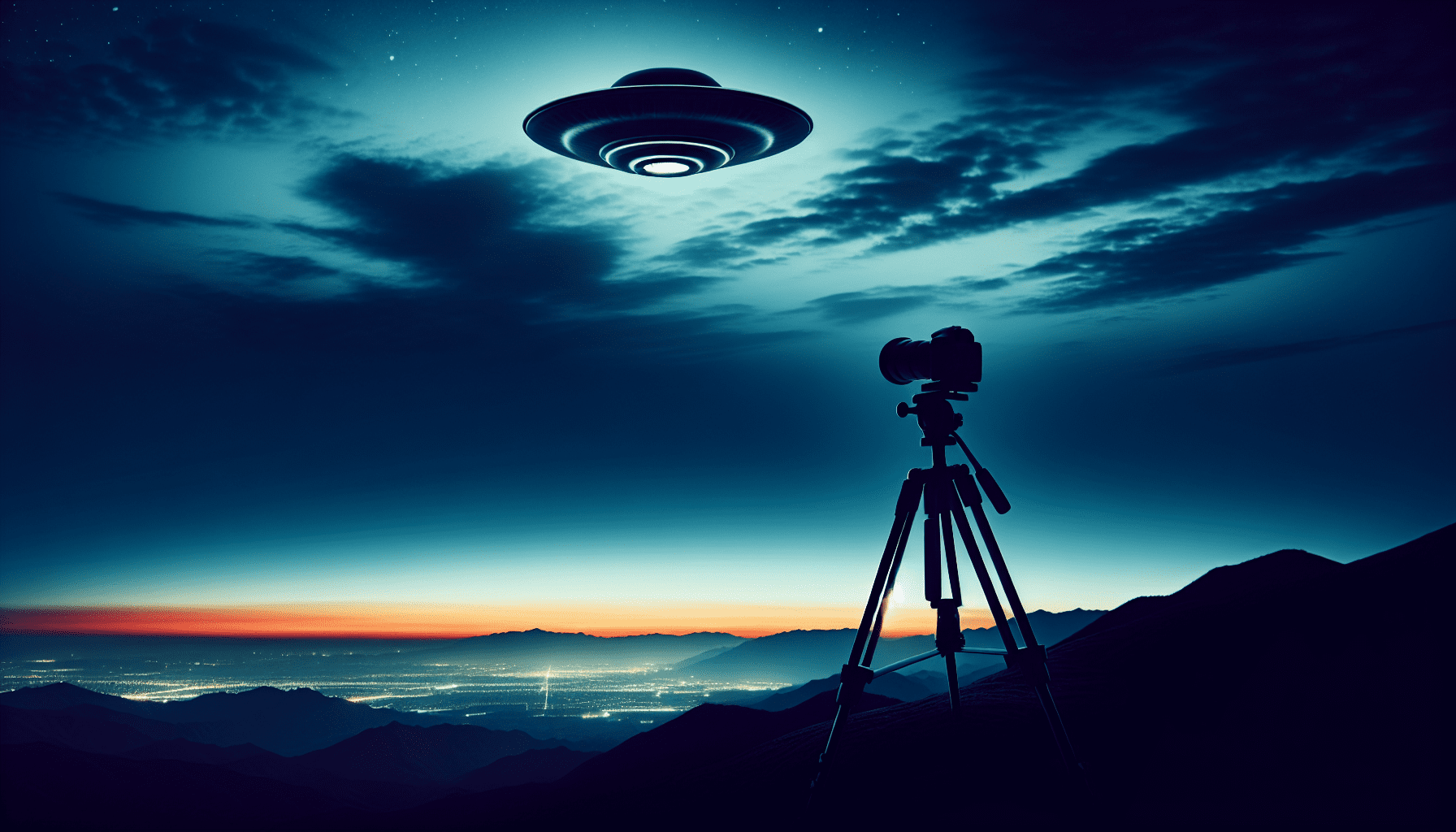Have you ever wondered how to capture evidence of UFO sightings near top-secret military bases? In this article, we will unravel the secrets and provide you with valuable tips on how to photograph UFOs. By following these simple steps, you will increase your chances of documenting these elusive encounters and contributing to the ongoing investigation of extraterrestrial activity. So grab your camera and get ready to unlock the mysteries of the skies!
Choosing the Right Equipment
When it comes to capturing UFOs near secret bases, having the right equipment is crucial. A camera with manual settings should be at the top of your list. This will allow you to have full control over your camera’s exposure, focus, and shutter speed, enabling you to capture clear and detailed images of UFOs.
Another essential equipment is a tripod. It provides stability and eliminates camera shake, especially during long exposures. This will come in handy when you need to capture UFOs that may appear in the night sky or in low light conditions.
To capture distant UFOs, a telephoto lens is essential. It allows you to zoom in on the object without compromising image quality. This is particularly useful when UFOs are seen at a distance from the secret bases.
In low light conditions or during night missions, consider using an infrared or night vision camera. These specialized cameras can capture images with enhanced clarity in situations where regular cameras struggle due to limited light.
Research and Location Selection
To increase your chances of photographing UFOs near secret bases, thorough research and careful location selection are key. Begin by studying reports and testimonials of UFO sightings in the area. This will give you a better understanding of previous encounters and potentially reveal patterns or trends.
Identifying potential secret bases is another crucial aspect of your research. Look for areas that show signs of restricted access, heightened security, or unusual activity. Satellite imagery can be a valuable tool in this process.
Researching UFO sighting hotspots can also be beneficial. These locations often have a higher frequency of reported sightings and may increase your chances of capturing UFOs on camera.
Additionally, consider vantage points near secret bases. Look for locations that provide a clear view of the sky and are in close proximity to the potential secret base. This will enable you to capture UFOs as they come and go from the secret facility.
Preparing for the Mission
Before embarking on your UFO photography mission, it is essential to prepare yourself and your equipment. Firstly, check the weather and atmospheric conditions. Inclement weather or poor visibility can greatly affect your chances of success. Choose a day when the sky is clear and the conditions are favorable for UFO sightings.
Pack your camera equipment carefully, ensuring you have all the necessary items. This includes the camera body, lenses, cleaning kit, lens filters, and any additional accessories that may aid in capturing UFOs. It’s better to be over-prepared than to miss an opportunity.
Always bring extra batteries and memory cards. A UFO sighting can be unexpected and may require prolonged periods of shooting. Having spare batteries and memory cards will ensure that you can capture as much evidence as possible without interruption.
Lastly, wear comfortable clothing suitable for the location. Consider the terrain, weather conditions, and the possibility of night shoots. Dress appropriately to ensure your comfort and safety during the mission.
Always inform someone about your mission before setting out. Share your plans, including the location you will be visiting and the duration of your outing. This step is important for personal safety and ensures that someone knows where you are in case of an emergency.
Understanding UFO Characteristics
To effectively capture UFOs on camera, it is essential to understand their characteristics. UFOs come in various shapes and sizes. They can range from classic saucer-like shapes to more irregular or unconventional forms. Familiarize yourself with the different shapes and be prepared to capture any variation you may come across.
Understanding movement patterns is also crucial. UFOs are often reported to move in ways that defy the capabilities of conventional aircraft. They can hover, make sudden turns, or disappear and reappear instantaneously. Be ready to track their movements and adjust your camera settings accordingly.
Pay attention to the light emissions of UFOs. They are often described as emitting bright lights, sometimes flashing or changing colors. Adjusting your camera’s exposure and white balance settings can help capture these characteristics accurately.
UFOs are often reported to have incredible speed and acceleration capabilities. Be prepared for sudden movements or high speeds by selecting appropriate shutter speeds. Adjusting the camera’s continuous shooting mode, also known as burst mode, can help capture rapid movements effectively.
Capturing UFOs
When setting up your equipment, choose a stable location with a clear view of the sky. Set up your tripod and secure your camera firmly to minimize movement and camera shake. Ensure that the camera is level and properly aimed at the target area of the sky.
Adjust your camera settings to maximize your chances of capturing UFOs. Set the camera to manual mode, allowing you to control the exposure, aperture, and shutter speed. Begin with a wide aperture to capture as much light as possible, and adjust your shutter speed accordingly to accommodate the lighting conditions.
Monitor the sky diligently while waiting for UFO sightings. Pay attention to any anomalies or objects that appear out of the ordinary. Be patient and observant, as UFO sightings may happen at unexpected times and may require you to act quickly.
Using burst mode is highly recommended when capturing UFOs. This mode allows the camera to take a rapid series of shots, increasing your chances of capturing the UFO at various stages of its movement.
Dealing with Challenges
When photographing UFOs near secret bases, you may encounter several challenges. Understanding aviation traffic is crucial to avoid mistaking conventional aircraft for UFOs. Familiarize yourself with flight patterns and altitudes of nearby airports or military bases to differentiate between normal aircraft and unidentified flying objects.
Identifying common flying objects, such as birds, drones, or balloons, can also be a challenge. Pay attention to their features, flight patterns, and behavior to distinguish them from true UFOs. Be vigilant and look for unique characteristics that set UFOs apart from other objects.
Differentiating between anomalous and natural phenomena is another challenge. Optical illusions, atmospheric conditions, and natural celestial objects can sometimes mimic the appearance of UFOs. Always investigate further before jumping to conclusions and consider other possible explanations.
Handling obstructions or interference can also occur during UFO photography missions. It’s important to be prepared for obstacles such as trees, buildings, or power lines that may obstruct your view. Additionally, be cautious of potential interference from lights or reflections that may distort your images. Patience and careful positioning can help minimize these challenges.
Analyzing and Sharing Evidence
After a UFO photography mission, it is important to review and organize the captured photos. Create a systematic approach to cataloging and storing the images for future reference. This will allow you to easily identify potential UFOs and review them in detail.
Enhance and zoom in on potential UFOs to get a closer look. Use photo editing software to adjust the brightness, contrast, and sharpness of the images. This can help reveal hidden details and anomalies that may not be visible at first glance.
Compare your findings with known UFO characteristics. Look for similarities in shape, movement patterns, and light emissions. This comparative analysis will help determine the credibility and potential significance of each captured UFO image.
If needed, use image or video stabilization techniques to minimize camera shake or jitteriness in your footage. This will enhance the overall quality of the visual evidence and make it easier for others to analyze.
Ensuring Credibility
To ensure the credibility of your UFO sightings, it is important to keep detailed records of each sighting. Document the time, location, and weather conditions during each encounter. This will provide a comprehensive account of the circumstances surrounding your observations.
Share unedited photos or videos with reputable UFO research organizations for analysis and verification. These organizations have the expertise to validate and potentially enhance your evidence. By collaborating with professionals in the field, you can gain valuable insights and contribute to the larger body of UFO research.
Consulting with experts in the field can also help verify and validate your findings. Seek out individuals or organizations with extensive knowledge and experience in UFO phenomena. Their expertise can provide an added layer of credibility to your evidence.
Maintaining Personal Safety
While photographing UFOs near secret bases can be thrilling, it is essential to prioritize personal safety. Adhere to all laws and regulations during your photography missions. Respect private property rights and avoid trespassing while searching for vantage points.
Stay vigilant and aware of your surroundings at all times. Ensure that you are not putting yourself in harm’s way, especially in unfamiliar or isolated locations. If a situation feels unsafe, it is best to remove yourself from it and seek alternative opportunities to capture UFOs.
Be cautious of potential dangers associated with the location. This may include wildlife, uneven terrain, or hazardous weather conditions. Take necessary precautions to mitigate these risks and ensure your own safety before anything else.
Joining UFO enthusiast communities can provide support and guidance throughout your journey. Connect with like-minded individuals who share your passion for UFO research. They can offer advice, share experiences, and provide a sense of camaraderie as you navigate the world of UFO photography.
Contributing to the Field
As a dedicated UFO photographer, you have the opportunity to contribute to the field in meaningful ways. Submit your evidence to reputable UFO research organizations. By sharing your findings, you contribute to a collective understanding of UFO phenomena and potentially aid in scientific research.
Participate in citizen science projects that focus on UFO research. These initiatives allow individuals to collaborate and contribute to scientific studies based on their firsthand experiences and evidence. By participating, you can actively contribute to the advancement of UFO research.
Share your experiences and findings with the community. Whether through online platforms, presentations, or local meetups, make an effort to communicate and engage with others interested in UFO phenomena. This shared knowledge promotes a sense of unity and encourages further investigation.
Collaborate with other dedicated UFO photographers and researchers. By working together, you can pool resources, share expertise, and validate each other’s findings. Collaboration enables a more comprehensive and holistic approach to UFO research.
In conclusion, photographing UFOs near secret bases requires careful planning, the right equipment, and a thorough understanding of UFO characteristics. By conducting comprehensive research, preparing properly, and remaining patient, you can increase your chances of capturing compelling evidence. Remember to prioritize personal safety, contribute to the field, and always approach your work with professionalism and credibility. Happy UFO hunting!

